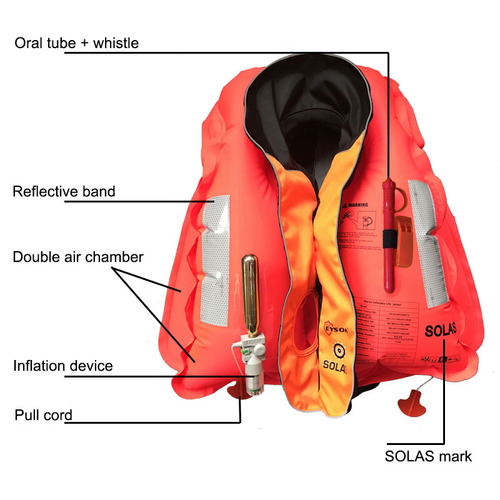Blog Post
What Are the SOLAS Inflatable Life Jacket Requirements?
Posted By: Harsh Bamnolia
Posted On : 24-Aug-2025

What Are the SOLAS Inflatable Life Jacket Requirements?
SOLAS inflatable life jacket requirements are a vital aspect of maritime safety, ensuring that every crew member and passenger has access to life-saving equipment that meets international standards.
These regulations are set by the International Maritime Organization (IMO) under the International Convention for the Safety of Life at Sea (SOLAS).
In this blog, we’ll walk you through what the SOLAS inflatable life jacket requirements entail, why they matter, and how to comply with them effectively.
Why SOLAS Inflatable Life Jacket Requirements Matter at Sea
When it comes to survival at sea, life jackets are not optional—they're mandatory. The SOLAS inflatable life jacket requirements are designed to ensure maximum safety during emergencies.
These jackets are specifically engineered to keep an unconscious person face-up in water and to provide sufficient buoyancy in various sea conditions.
Maritime disasters, such as ship collisions, capsizing, or man-overboard scenarios, highlight the importance of having compliant and effective life-saving equipment.
Non-compliance with SOLAS inflatable life jacket requirements can not only risk lives but also attract heavy penalties during maritime inspections.
What Are the Core SOLAS Inflatable Life Jacket Requirements?
The SOLAS inflatable life jacket requirements are outlined in Chapter III of the SOLAS Convention and include specific performance, design, and usage criteria. Here's what these requirements typically cover:
Buoyancy: Each inflatable life jacket must provide a minimum of 150N (newtons) of buoyant force for adults and 100N for children. This ensures that the jacket can keep an unconscious person’s head above water.
Automatic Inflation System: According to SOLAS inflatable life jacket requirements, each jacket must inflate automatically upon immersion. However, they must also be equipped with a manual inflation mechanism as a backup.
Whistle and Light: A SOLAS-compliant inflatable life jacket must come with a pealess whistle and a self-activating light that works in saltwater and is visible from a significant distance.
Retro-Reflective Tape: To enhance visibility during night rescues, the jacket must be fitted with retro-reflective tape across vital areas such as shoulders and chest.
Thermal Protection: Some SOLAS inflatable life jackets include additional thermal protection layers to minimize hypothermia risk.
Secure Fastening System: The jacket should include a crotch strap and reliable fastening mechanism to prevent it from slipping off during water entry or rescue operations.
Additional SOLAS Inflatable Life Jacket Requirements for Cargo and Passenger Ships
For commercial shipping and passenger vessels, SOLAS inflatable life jacket requirements are stricter:
Sufficient Quantity: Ships must carry life jackets for every person on board, including additional units in specific locations like muster stations, lifeboats, and on open decks.
Special Provisions for Children & Infants: Vessels are required to have child-sized life jackets and instructions available for proper use. In some cases, life jackets for infants are also mandatory.
Crew Training & Inspection: Crew members must undergo regular drills that include the donning and operation of inflatable life jackets. Additionally, the jackets must be inspected monthly and serviced annually by authorized professionals.
Storage & Accessibility: Jackets should be easily accessible, stored in dry, clearly marked locations, and must not be kept in locked compartments.
Testing & Certification of SOLAS Inflatable Life Jackets
To meet SOLAS inflatable life jacket requirements, manufacturers must submit their products for rigorous testing. Certified testing agencies conduct evaluations that simulate real-life conditions such as:
Water immersion with and without clothing
Impact resistance during sudden deployment
Saltwater corrosion resistance
High and low-temperature functionality
Once the jacket passes these tests, it receives the SOLAS certification mark, which includes a unique serial number, manufacturing date, and inspection due date.
These certified jackets are then listed in IMO's approved life-saving equipment directory, making it easier for vessel owners to procure compliant products.
Key Considerations While Buying SOLAS-Compliant Inflatable Life Jackets
If you're a shipowner or responsible for maritime procurement, choosing the right inflatable life jacket is crucial. Keep the following in mind to ensure adherence to SOLAS inflatable life jacket requirements:
Always check for SOLAS certification.
Choose jackets with dual inflation (automatic + manual).
Confirm visibility features like light, whistle, and tape.
Ensure that sizing options (adult, child, infant) are available.
Partner with certified suppliers who provide post-sale servicing.
Avoid bulk buying from unknown vendors, especially if you’re operating international vessels that face regular port inspections.
Consequences of Non-Compliance with SOLAS Inflatable Life Jacket Requirements
Neglecting SOLAS inflatable life jacket requirements can result in:
Failed Port State Control (PSC) inspections
Heavy fines and detentions
Increased liability in case of onboard emergencies
Higher insurance premiums
Reputational damage
Most importantly, non-compliant life jackets put your crew and passengers at serious risk.
FAQ: SOLAS Inflatable Life Jacket Requirements
Q1: How often should SOLAS inflatable life jackets be serviced?
A: They must be inspected monthly and serviced annually by a certified technician.
Q2: Are SOLAS inflatable life jackets mandatory for all vessels?
A: Yes, all international commercial vessels and passenger ships must carry them.
Q3: Can SOLAS life jackets be reused after deployment?
A: Only if they’re rearmed and pass inspection by a licensed service provider.
Q4: What’s the minimum buoyancy required by SOLAS for life jackets?
A: 150N for adults and 100N for children.
Q5: Can recreational boats use SOLAS life jackets?
A: They can, but they are not mandatory for domestic use unless regulated locally.
Conclusion: Stay Compliant, Stay Safe
Understanding and complying with SOLAS inflatable life jacket requirements is not just a legal obligation—it's a life-saving necessity.
These internationally recognized standards ensure that life jackets are built to perform under the most challenging sea conditions.
Whether you own a cargo ship, passenger vessel, or yacht, equipping your crew with SOLAS-compliant inflatable life jackets could mean the difference between life and death during an emergency.
Need help choosing SOLAS-certified safety equipment or scheduling a servicing?
Reach out to trusted marine safety service providers today to ensure your crew is protected and your vessel is compliant.